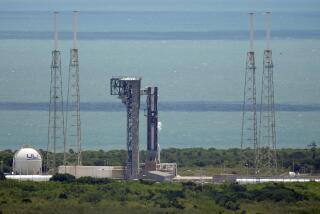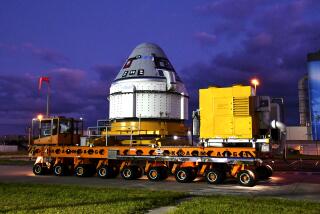NASA delays moon-mapping mission by a day
Continuing delays in the launch of the space shuttle Endeavour caused NASA managers on Monday to move back the scheduled launch of the Lunar Reconnaissance Orbiter moon-mapping mission by a day, to no earlier than Thursday.
Endeavour’s launch, originally planned for Saturday at Cape Canaveral in Florida, was delayed by a leak in the hydrogen venting system on the shuttle’s giant external fuel tank, NASA said. The mission, which will continue construction of the International Space Station’s Japanese laboratory, known as Kibo, has been rescheduled for a Wednesday morning launch.
Launch of the reconnaissance orbiter and its companion, the Lunar Crater Observation and Sensing Satellite, had to be bumped back a day to Thursday because the mission is launching from the same complex as Endeavour, mission managers said at a news briefing at Kennedy Space Center.
The moon mission’s launch window extends through Saturday. If it can’t launch by then, the changing alignments of the sun, moon and Earth will force an additional delay until June 30.
The combination orbiter and satellite mission comprises the first step toward returning humans to the moon by 2020. The orbiter will map the moon in more detail than has ever been attempted, searching out the safest and most advantageous sites for a future lunar colony.
The sensing satellite, meanwhile, has only one purpose, to search for ice in perpetually shadowed craters.
To do this, the satellite will aim an empty rocket stage toward a crater at the south pole. The crash should send debris as much as six miles above the lunar surface. Before crashing itself, the satellite will fly through the debris plume, taking measurements in hopes of finding evidence of water.
Water is valuable not only because it could save colonists from having to bring it from Earth, but also because it could be broken down into oxygen and hydrogen for use in respiration as well as rocket fuel.
NASA hasn’t yet decided which crater to hit. It has several possibilities, based on previous missions that found large signatures of hydrogen at both poles, which could be indicators of water. The final decision won’t be made until about 30 days before the planned crash date, scheduled for Oct. 9.
NASA hopes to have thousands of amateur astronomers, along with the professionals, aiming their telescopes skyward when the rocket plunges into the moon.
--






